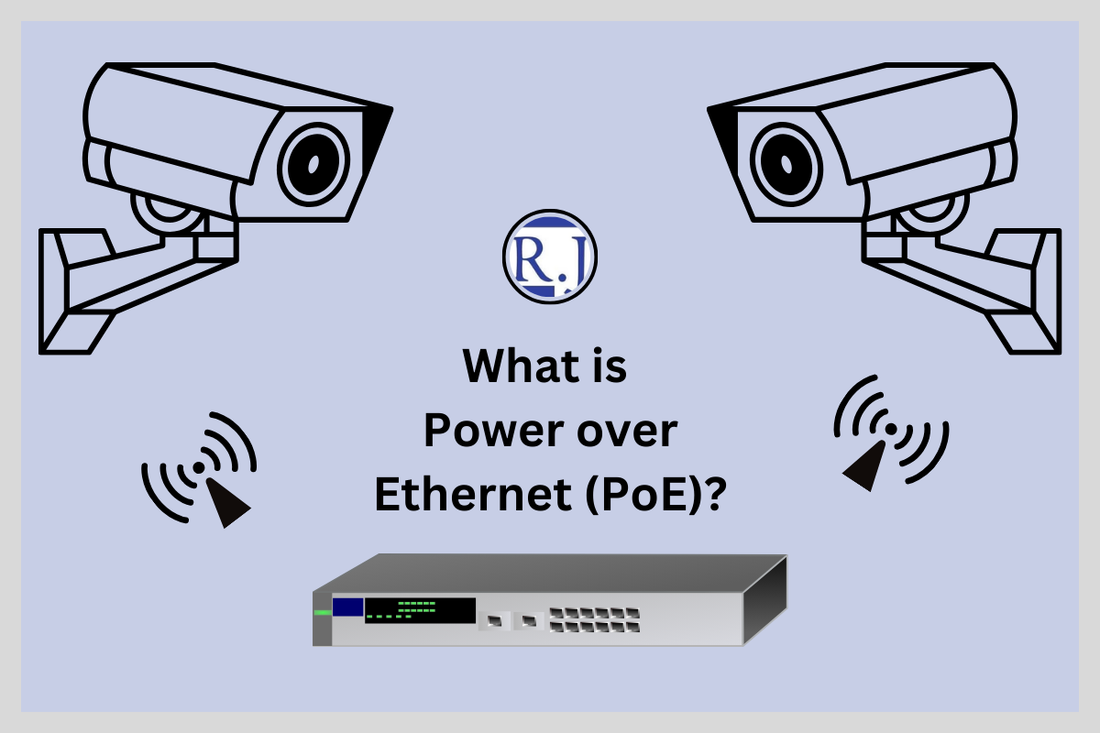
What is Power over Ethernet (PoE)?
Share
If you’ve ever handled Ethernet cabling or read some product description of electrical equipment, you may have come across the term “PoE” or “PoE+”. But what does this term even mean? How does it relate to an Ethernet network? PoE can be a complex concept for beginners to understand, but that’s why you’re here! This blog will break down the basics of PoE; what it’s used for, how it works, and more!
What is PoE?
PoE, short for Power over Ethernet, is a technology system that transmits power between devices over Ethernet cables instead of traditional power cords. This allows the network cables to function two roles in carrying data and power by eliminating the need for a separate power source.
How does PoE Work?
Simply put, every PoE system is composed of two key components: the power sourcing equipment (PSE) and the powered devices (PDs). A PSE (such as a PoE-enabled switch or injector) sends power alongside the data in an Ethernet cable, while a PD (e.g. Wi-Fi APs, VoIP phones, etc.) extracts the power to operate.
Difference between PoE, PoE+, and PoE++
Just as the name suggests, the pluses in each different PoE type indicates a different standard. These standards dictate how much power is delivered to ensure compatibility and operability between connected powered devices and power sourcing equipment.
- PoE, or 802.3af – supports up to 15.4W per port
- PoE+, or 802.3at – supports up to 30W per port
- PoE++, or 802.3bt – supports up to 60W (with Type 3) and 100W (with Type 4)
It should be noted that each standard is able to provide backward compatibility. And naturally to utilize a higher standard, the appropriate cabling requirements must be met as well.
What Devices Utilizes PoE?
Development in PoE over the years has led to more and more devices being PoE-compatible. Some of the more common compatible devices include:
- IP cameras
- Wireless access points
- VoIP phones
- Laptops
- Smart lighting systems (e.g. LEDs)
- Internet of Things (IoT) sensors
- Self-serve kiosks/payment terminals
But as PoE standards and technology advances to support larger power consumptions, it’s becoming more and more common to see traditionally separate mechanisms such as HVAC being combined with smart management systems like phones.
What Are Some Common PoE Applications?
Interconnectivity is a highly valued aspect of our world today. In our day-to-day life, PoE is also becoming more prevalent because of its advantages over non-PoE devices and contribution to connectivity. Some of their applications include:
-
Networking and Communications
- Wi-Fi APs (or wireless access points) are one of the devices that benefits the most from PoE. Similarly, in Ethernet networking having a singular line of connection for your devices is extremely useful in reducing electrical installations and additional outlets.
-
In a communications setting, such as phone lines – having less cables will make maintenance and troubleshooting a lot easier. Plus, less cable also means less clutter! Giving your office a cleaner aesthetic.
-
Data Centers and Other IT Infrastructures
-
In data centers, every space (especially the ones in a server rack) is often heavily scrutinized and optimized for efficiency. Structured cabling is just one part of this efficiency process, but it plays a large role in maintaining fast and stable operations. Some equipment, like our patch panels, are PoE-compatible. This way, you can easily integrate them into your data center networks without losing performance.
- It should be noted that most regular patch panels do not support wattage over 15.4 (or the standard PoE). However, high density patch panels like the HDPP-48-C6 has no problem supporting PoE++ (or 60W).
- Newer computers and laptops are starting to include PoE technology. One notable example would be the Macbook. With a USB-C Ethernet adapter cable, you’re able to transmit both data and power – saving you the need for additional wires and more room for other integrations.
-
In data centers, every space (especially the ones in a server rack) is often heavily scrutinized and optimized for efficiency. Structured cabling is just one part of this efficiency process, but it plays a large role in maintaining fast and stable operations. Some equipment, like our patch panels, are PoE-compatible. This way, you can easily integrate them into your data center networks without losing performance.
-
Security
-
PoE applications in security systems are also extremely useful. They can be used in conjunction with IP cameras to simplify the installation process and ensure all relevant devices are connected on one network. Other security devices like access control systems can be easily managed with PoE and prevent abuse.
-
PoE applications in security systems are also extremely useful. They can be used in conjunction with IP cameras to simplify the installation process and ensure all relevant devices are connected on one network. Other security devices like access control systems can be easily managed with PoE and prevent abuse.
-
Smart Buildings
- Perhaps the application with the most potential is PoE in smart buildings. Smart buildings are buildings that combine all traditional systems such as lighting, HVAC, and security into a singular network infrastructure.
-
PoE is one of the foundational technologies in developing these smart buildings, because it offers lower operational costs, lower energy costs, and greater flexibility.
Advantages of PoE
- Simplifies installation – removes the need for a separate power line and extra cable management. Certain devices such as exterior cameras benefit greatly from this simplified process because they easily route all of your cables to the intended locations.
- Reduces cost – a centralized unit that functions as both a data and power transmitter saves money by reducing cabling needs and outlet. Since the release of the first PoE standards back in 2003, power over Ethernet has been widely adopted – helping reduce cost with new technology.
- Reliable – PoE standards include built in safeguards against incorrect installation and allowed for the development of universal compatibility between devices and power sources.
- Ease of access – devices across an Ethernet network can be utilized anywhere so long as there is Ethernet connection.
Disadvantages of PoE
- Power limits – devices that require higher wattages may not be supported by older PoE standards. Additionally, devices that require larger amounts of power such as garage doors will not be operable with solely PoE power.
- Outages – a loss in power in a switch or injector can affect all connected devices due to them being on the same connection.
- Distance limit – power transmission can be limited due to Ethernet cables having a maximum length of 100 meters before power integrity is effected.
How to Increase Power over Ethernet Performance
With PoE you can achieve cohesiveness and continuity in your network unlike ever before. However, one of the biggest limitations of the system is the limits of the Ethernet cable itself. In a large office building or a smart apartment complex, the 100 meter limitation of the cable can prove to be an obstacle when setting up devices throughout the building. Generally, the easiest and most straightforward method would be to set up various PoE systems throughout the building. However, if you want to achieve a super connected network, PoE extenders do exist!
Is PoE Technology Safe to Use?
Yes, in most cases. Power over Ethernet contains protection mechanisms that will help prevent electrical overload. This mechanism does this by ensuring that direct current (DC) is only delivered when a connected device is compatible. Of course, the best practice is to make sure that each device is connected and that you are using quality cables in your network.
Damage Prevention from PoE
Other methods and actions you can take to prevent damage and increase the safety of your setup, is by being methodical with your equipment. First and foremost, make sure there is compatibility between your network devices. PoE devices will not harm non-PoE devices because of its built-in system. Before sending power, the PSE will first identify and determine if the connection supports PoE. If during this detection, the PSE determines otherwise, electricity will not be sent. However, compatibility between other equipment such as cables is just as important to prevent power loss and damage. Other executables you can take is performing regular inspection of your PoE network. This way you can quickly identify and apply fixes to any potential issues and ensure the longevity of your devices.
How Can You Prevent Power Outages?
Another limitation of PoE is in the event of a power outage, your entire network may be inoperable. This is because of the nature of a power over Ethernet system, but just like normal electrical networks – there are easy fix solutions. You can set up redundancies such as another UPS to ensure operations remain uninterrupted.
For networks that have critical operations, such as data centers, this is a highly recommended solution. For less important applications, this is still a recommended solution to prevent sudden power loss affecting your work.
Should You Invest In A PoE System?
Yes, absolutely. PoE has been around for over 20 years and has shown its worth in our modern day networking. Having PoE-powered devices helps integrate your devices and even appliances into one cohesive network.
The potential applications of power over Ethernet is almost endless. In today’s world, we already see this technology being applied in classrooms where interactive whiteboards are being used more and more. In large public spaces, this technology is applied in security cameras and publicly accessible Wi-Fi points. And in private spaces like hotels, PoE is used to reduce cost and enhance their guests' experience with wireless access points and phone lines.
Whether you’re considering using power over Ethernet to ensure the reliability of your security cameras or using it to run a wireless access point, PoE is a sure bet solution.








